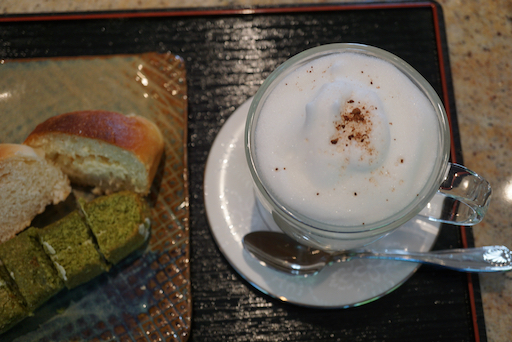We were offered a digital baking cookbook from Washington Post by email to use during the covid-19 stay-at-home period. (We subscribe to the digital version of WP having given up on the paper version many years ago). One of the recipes in the cookbook was for no knead English muffin, and it piqued our interest. I used to make English muffins and even have metal rings in which to bake them. But the dough was so sticky just getting a portion of it into the rings was a struggle. My wife, started baking English muffin bread so I stopped making English muffins. Even so, getting the dough into the loaf pans requires a pair of scissors and some finesse. This recipe, however, sounded interesting and also looked easier to make despite taking a long time for the dough to rise. The picture below shows the final product toasted and buttered after my wife carefully separated the muffin into two halves using a fork.
Digression alert: according to my wife this fork method, which she learned eating many English muffins as a child, is "de rigueur" for cutting them into halves. It's done by inserting the tines of a fork from the edge of the muffin toward the center multiple times around the entire perimeter. Once this is done it easily pulls apart with just a gentle tug. As you can see from the picture it works pretty well. The two halves remain intact and the nice nooks and crannies are preserved. The original recipe calls for pulling them apart by inserting your thumbs and pulling with your fingers...needless to say, my wife quickly vetoed that method after she saw the mangled mess that resulted from my attempt to implement it.
Digression alert: according to my wife this fork method, which she learned eating many English muffins as a child, is "de rigueur" for cutting them into halves. It's done by inserting the tines of a fork from the edge of the muffin toward the center multiple times around the entire perimeter. Once this is done it easily pulls apart with just a gentle tug. As you can see from the picture it works pretty well. The two halves remain intact and the nice nooks and crannies are preserved. The original recipe calls for pulling them apart by inserting your thumbs and pulling with your fingers...needless to say, my wife quickly vetoed that method after she saw the mangled mess that resulted from my attempt to implement it.
Ingredients:
2 cups bread flour
1 cup whole-wheat flour
2 teaspoons kosher salt
1 1⁄4 teaspoons instant yeast
1 1⁄2 cups cold milk (any percentage)
1⁄4 cup honey
1 large egg white, cold
1 cup fine cornmeal, for dusting
2 tablespoons or more unsalted butter for cooking
Directions:
Mix together the dry ingredients and then add the wet ingredients, mix well with a spatula until smooth but sticky dough forms (#1). Cover the bowl with plastic wrap and let the dough rise for 4-5 hours in warm place. Dust a rimmed cookie sheet with the corn meal and drop on scoops of the dough using a large spoon (#2). Dust the surface of the dough with additional cornmeal and cover with a plastic wrap and place it in the refrigerator for 12 hours (we did this over night). The dough spread out so each dollop was almost touching each other (#3). Heat up a large cast iron skillet on medium low flame and when it is hot, add the butter (#4). Using a spatula, put the dough portions into the skillet (#5) and cook 6-7 minutes turning the dough 180 degrees half-way through cooking to get an even browning (our first batch was a bit over browned). Flip the muffins over and cook the other side (#6). My wife inserted a bamboo skewer from the side to the center to make sure the muffin was cooked. We put the cooked muffin in the wire rack to cool.
These muffins were our combined effort. The next morning, we cooked up the muffins and they were great. Although it takes time to prepare the dough, it is much easier to make than what I went through before. The addition of the whole wheat flour made it much better than just making it with white flour. The whole wheat flavor really came through with a mild nuttiness. Also, the butter became richly browned and added another wonderful taste dimension. We will make these again for sure. We can improve these in two ways; 1. reducing the salt in half (above we reduce to 2 tsp)--it tasted too salty to us and 2. Use lower heat to cook the muffin. The heat was too high and especially the first batch- came out too brown. Making the English muffin reminded us of naan we made which was also very good. Maybe we should make that again.























